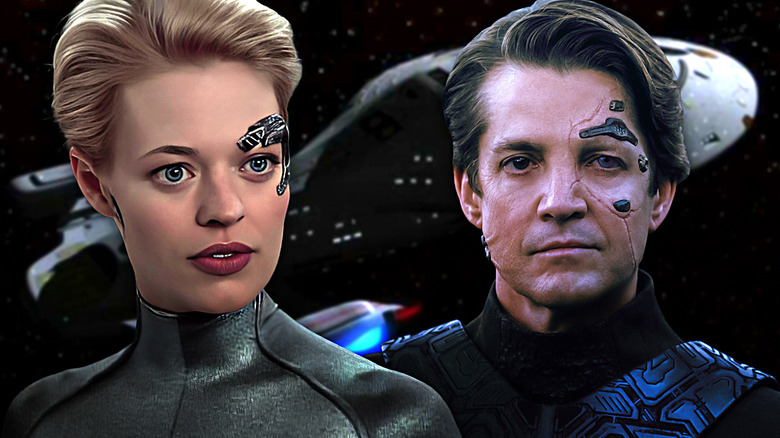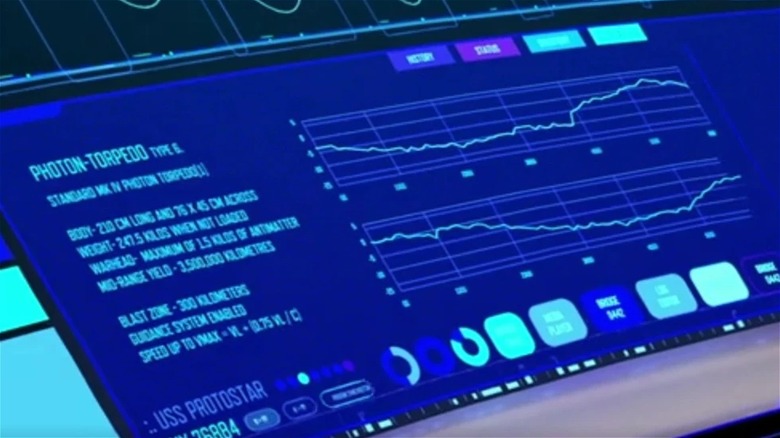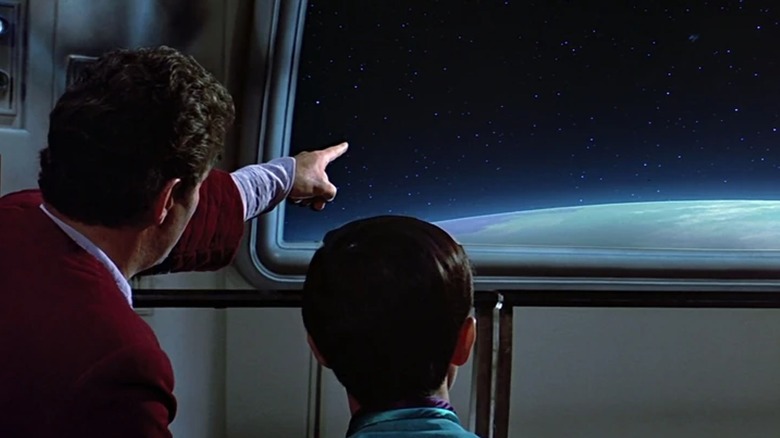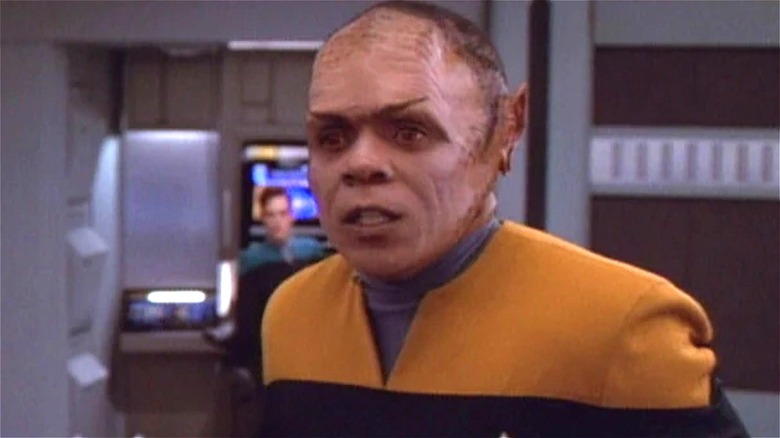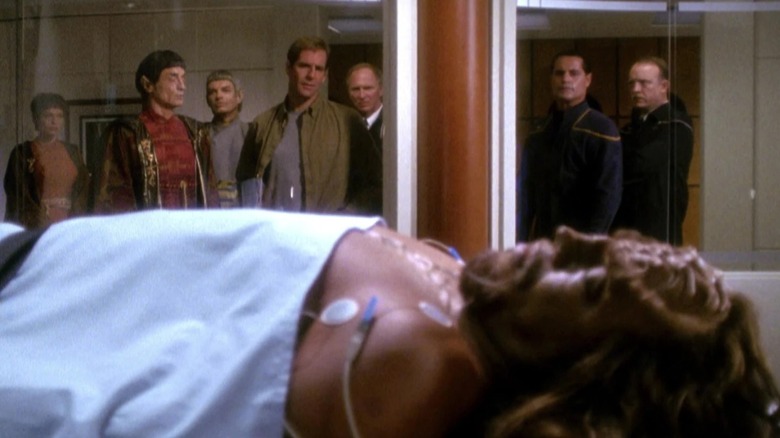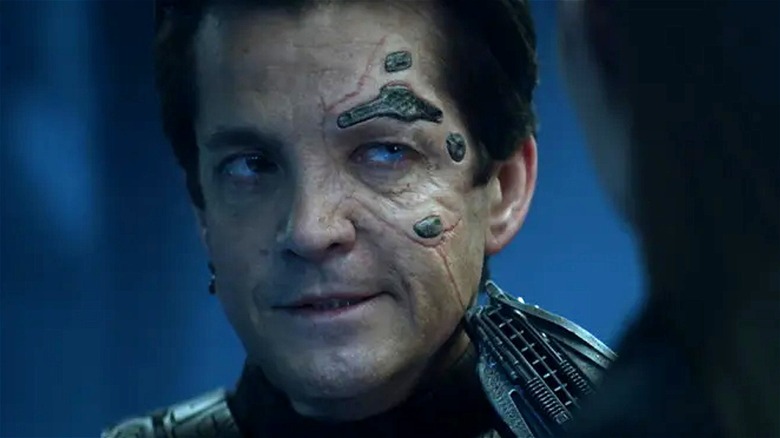Star Trek Continuity Errors Fans Can't Ignore
"Star Trek" is a sci-fi franchise that offers a little something for everyone. There's optimism for humanity's future, nuanced explorations of sociopolitical issues, and passionately delivered speeches from Shakespearean actor Patrick Stewart. There's also a seemingly limitless stream of bizarre space anomalies, Holodeck LARPing, and strange species like the Ocampans with their mathematically nonsensical reproductive cycle. Of course, the longer and more complicated the world of Starfleet becomes, the harder it is for its writers to keep everything straight.
Unlike many of the franchise's most diehard fans, Star Trek creator Gene Roddenberry wasn't always tied down to a strict vision of canon. Instead, he felt that many of the world's inconsistencies could be explained away after the fact. As he wrote in his introduction to the "Star Trek: The Next Generation Technical Manual," "[C]onsidering the sometimes crushing pressures under which episodic television is produced, I'm quite amazed at how well it usually hangs together."
But as much as we love Starfleet, it's still fun to dissect some of Star Trek's biggest on-screen mistakes and plot holes. From an epic first contact fail to a mystifying mirror universe mystery, here are some of the biggest continuity errors from across the entire Star Trek franchise.
Voyager's bottomless store of torpedoes and shuttlecraft
From the existential terror of replacing Harry Kim with an exact duplicate to casually populating a planet with Warp 10 post-human salamander babies, "Star Trek: Voyager" committed to some strong writing decisions. In a series so willing to throw everything from Starfleet values to basic Star Trek universe rules everyone has to follow out the airlock, it makes perfect sense that "Voyager" writers couldn't give a flying tribble about continuity. And nowhere is this more obvious than the starship's apparently limitless supply of torpedoes and shuttlecraft.
Stranded in the Delta Quadrant, the U.S.S. Voyager has no way to replenish its arsenal short of fabricating new ammunition. It's a fact that Tuvok states directly early on in the Season 1 episode "The Cloud" when he reports, "We have a complement of 38 photon torpedoes at our disposal, Captain," to which Janeway grimly responds, "And no way to replace them after they're gone." For anyone keeping count, they've blown through around 15 of these all-purpose space bombs by the two-parter episode "Basics," linking Seasons 2 and 3. This causes Janeway to remark of the Kazon, "They may have torpedoes to waste, but we don't." Unless they've fabricated more at some point, the Voyager should run completely out of torpedoes around the time they pick up Seven of Nine and begin modifying torpedoes for combat with the Borg.
According to YouTuber TazG2000's Voyager torpedo compilation, the final photon torpedo count stands at -85 by the end of the series, with the show's writers effectively giving up on continuity altogether by Season 5. The ship's shuttlecraft count runs a similar course, with the Star Trek Nitpickers counting a total of seven lost shuttles by the series finale.
The inconsistency of cloaking technology
Star Trek's ship cloaking is the ultimate stealth technology. But unlike today's real-world stealth jets, the cloaking devices in Star Trek can render a ship invisible not only to sensors but also to the naked eye, generally by manipulating light and the electromagnetic spectrum. Although the Treaty of Algernon would eventually prevent the Federation from adding this tech to Starfleet's ships, the agreement doesn't keep everyone else, from the Breen to the Klingons to the Suliban, from sneaking around the galaxy.
Everything, from the history of cloaking technology to how it works, is handled so inconsistently throughout the franchise that it's often considered one of the biggest errors in the sci-fi franchise's universe. While most of these details can be brushed off as questionable things we choose to ignore in Star Trek, the entire premise of the "Star Trek: Deep Space Nine" episode "The Emperor's New Cloak" hinges on the canonically inconsistent claim that there is no cloaking technology in the mirror universe.
The plot finds Grand Nagus Zek (Wallace Shawn) grabbed by the Klingon-Cardassian Alliance while away on business in the mirror universe. In exchange for his safe return, the Alliance wants a cloaking device, as these don't exist in the alternate reality. The absence of cloaking tech in the mirror universe is confirmed by Mirror Worf (Michael Dorn), Regent to the Alliance, and Mirror Kira Nerys (Nana Visitor). The problem? This episode is set in Season 7 of "Deep Space Nine," a full four seasons after Benjamin Sisko (Avery Brooks) and Miles O'Brien (Colm Meaney) witness Klingon and Cardassian ships uncloaking in the mirror universe episode "Through the Looking Glass."
The great transporter accident conspiracy
The "Star Trek: The Next Generation" episode "Realm of Fear" revolves around the Enterprise-D's resident holaddict Reginald Barclay (Dwight Schultz) and his serious anxieties about transporter safety. To allay Barclay's fears, Chief Engineer Geordi La Forge (LeVar Burton) asks, "Reg, how many transporter accidents have there been in the last ten years? Two? Three? There are millions of people who transport safely every day without a problem." Moments later, he adds, "Reg, transporting really is the safest way to travel."
Whether this is an outright lie as part of a far-reaching Starfleet conspiracy concocted to hide how Star Trek's transporters actually work or simply a boss gaslighting his employee into workplace safety violations is up for debate. But either way, Geordi's statement can't possibly be true based on the many, often existentially terrifying transporter accidents in the Star Trek franchise.
Early Starfleet history should be full of transporter reports from transporter accidents like the one that caused the delayed death of the transporter inventor's son in the "Star Trek: Enterprise" episode "Daedalus" and Hoshi Sato's horrifying hallucinations in "Vanishing Point." By 2269, in the "Original Series" episode "The Savage Curtain," NCC-1701's Chief Engineer Montgomery Scott (James Doohan) warns Bones (DeForest Kelley) that without enough power, anyone they beam up will "come aboard a mass of dying flesh." From the grisly transporter accident deaths of "Star Trek: The Motion Picture" and Weyoun 5's death in "Deep Space Nine" to Riker's double Thomas Riker in "Second Chances" and the Tuvix debacle in "Voyager," Starfleet history is positively riddled with transporter horrors.
Who botched Klingon first contact
Aside from not violating the Prime Directive, making sure that first contacts with new cultures run smoothly is one of the Federation's biggest priorities. Emphasizing the importance of a well-planned initial meeting in "The Next Generation" episode "First Contact," Captain Jean-Luc Picard (Patrick Stewart) tells Malcorian Chancellor Durken (George Coe), "[T]here is no starship mission more dangerous than that of first contact." He goes on to cite Starfleet's "disastrous" experience with the Klingon Empire as a reason for performing surveillance before initiating an encounter with a new race, noting that the botched original meeting with the Klingons precipitated decades of war.
But when humanity's first contact is finally shown in the "Star Trek: Enterprise" pilot "Broken Bow," the only thing it seems to lead to is the Klingons' mild annoyance at their interaction with Jonathan Archer (Scott Bakula). And that's to say nothing of the fact that Klingons were clearly already warp-capable by the time Klaang crash-landed on Earth, which seems to contradict Picard's suggestion about the need to monitor pre-warp races before initiating first contact. In "Star Trek: Discovery," mutineer Michael Burnham's (Sonequa Martin-Green) role in the Klingon War muddles things further by turning Starfleet's next major interaction with the race into the start of the Klingon-Federation war in "The Vulcan Hello."
The fact that Picard never quite says who was responsible for the first contact disaster has led plenty of Trekkies to conclude that the captain was referring to Vulcan-Klingon relations rather than anything to do with humanity. But the theory quickly falls apart on closer scrutiny since the decades-long Klingon-Federation war doesn't actually kick off until Michael Burnham's mutinous shenanigans.
The only Borg to leave the collective
For someone hellbent on assimilating everyone, the Borg Queen has sure had her share of dysfunctional relationships with Earth folks, from the sexual relationship she initiated with Data to the twin flame situationship she tried to ignite with Locutus. Still, no one seems to get the Borg Queen's circuits crackling like Seven of Nine. And like every other narcissistic ex in history, Queenie will say just about anything to get Seven back, which is why we should probably take anything she says with a grain of salt.
Still, it's hard to tell if she's outright lying or just another casualty of "Star Trek" writers' continuity slip-ups when the Borg Queen tells Seven she wants her because of her uniqueness. As the queen puts it, "You are the only Borg that has ever returned to a state of individuality."
The problem is that Seven isn't the only Borg to leave the collective — she wasn't even the first. As far as on-screen canon goes, that honor goes to Captain Picard, who joins the ex-Borg club after he is assimilated and spends the better part of a week rampaging as Locutus in "The Best of Both Worlds." The next person to join the ex-Borg club is Designation Third of Five, who later takes the name of Hugh (Jonathan Del Arco) after leaving the collective in the "Next Generation" episodes "I, Borg" and "Descent." All of this takes place years before the entire Seven of Nine timeline — which means the Borg Queen was probably just hot for Seven's Borg implants.
